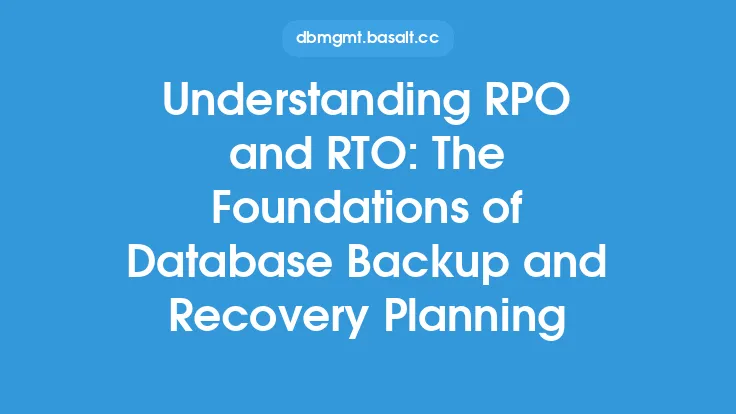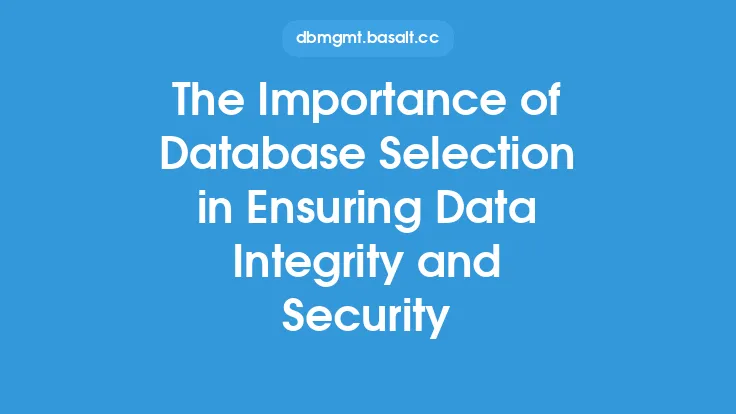Disaster recovery planning is a critical aspect of database management, as it ensures the continuity of business operations in the event of a disaster or major disruption. One of the key areas where disaster recovery planning has a significant impact is on database security and compliance. In this article, we will explore the relationship between disaster recovery planning and database security and compliance, and discuss the importance of considering these factors when developing a disaster recovery plan.
Introduction to Database Security and Compliance
Database security and compliance are essential components of database management, as they ensure the confidentiality, integrity, and availability of sensitive data. Database security refers to the measures taken to protect the database from unauthorized access, use, disclosure, disruption, modification, or destruction. Compliance, on the other hand, refers to the adherence to relevant laws, regulations, and standards that govern the management and protection of sensitive data. Disaster recovery planning plays a critical role in ensuring database security and compliance, as it provides a framework for responding to disasters and minimizing the impact on the database and its data.
The Impact of Disaster Recovery Planning on Database Security
Disaster recovery planning has a significant impact on database security, as it helps to ensure the continuity of security measures in the event of a disaster. A well-developed disaster recovery plan should include procedures for restoring security measures, such as access controls, encryption, and firewalls, in the event of a disaster. This ensures that the database and its data remain secure, even in the face of a disaster. Additionally, disaster recovery planning helps to identify potential security risks and vulnerabilities, and provides a framework for mitigating these risks. For example, a disaster recovery plan may include procedures for responding to a security breach, such as notifying affected parties, containing the breach, and restoring security measures.
The Impact of Disaster Recovery Planning on Database Compliance
Disaster recovery planning also has a significant impact on database compliance, as it helps to ensure adherence to relevant laws, regulations, and standards. A well-developed disaster recovery plan should include procedures for ensuring compliance with relevant regulations, such as data protection and privacy laws. For example, a disaster recovery plan may include procedures for notifying affected parties in the event of a data breach, or for ensuring the confidentiality and integrity of sensitive data during the recovery process. Additionally, disaster recovery planning helps to identify potential compliance risks and vulnerabilities, and provides a framework for mitigating these risks. For example, a disaster recovery plan may include procedures for ensuring the availability of audit logs and other compliance-related data, even in the event of a disaster.
Key Considerations for Database Security and Compliance in Disaster Recovery Planning
When developing a disaster recovery plan, there are several key considerations for database security and compliance. First, the plan should include procedures for restoring security measures, such as access controls, encryption, and firewalls, in the event of a disaster. Second, the plan should include procedures for ensuring compliance with relevant regulations, such as data protection and privacy laws. Third, the plan should include procedures for identifying and mitigating potential security and compliance risks and vulnerabilities. Finally, the plan should include procedures for testing and updating the disaster recovery plan, to ensure that it remains effective and compliant with relevant regulations.
Best Practices for Ensuring Database Security and Compliance in Disaster Recovery Planning
There are several best practices for ensuring database security and compliance in disaster recovery planning. First, organizations should conduct regular risk assessments to identify potential security and compliance risks and vulnerabilities. Second, organizations should develop a comprehensive disaster recovery plan that includes procedures for restoring security measures and ensuring compliance with relevant regulations. Third, organizations should test and update the disaster recovery plan regularly, to ensure that it remains effective and compliant with relevant regulations. Finally, organizations should provide training and awareness programs for employees, to ensure that they understand the importance of database security and compliance in disaster recovery planning.
Conclusion
In conclusion, disaster recovery planning has a significant impact on database security and compliance, as it provides a framework for responding to disasters and minimizing the impact on the database and its data. A well-developed disaster recovery plan should include procedures for restoring security measures, ensuring compliance with relevant regulations, and identifying and mitigating potential security and compliance risks and vulnerabilities. By following best practices and considering key considerations for database security and compliance, organizations can ensure the continuity of business operations and the protection of sensitive data, even in the face of a disaster.





